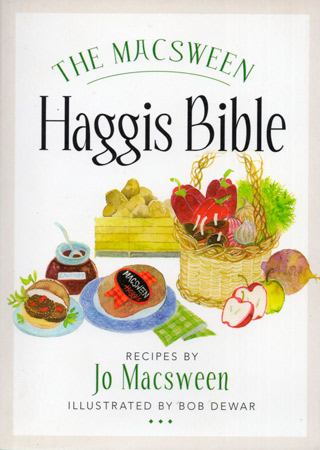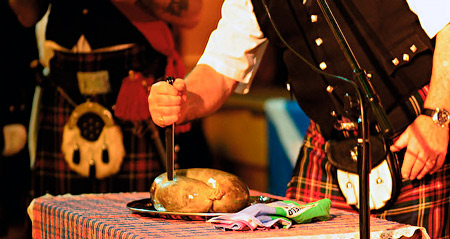A Bible even the Editor could appreciate.
Macsween’s of Edinburgh must be the most celebrated of haggis butchers, its product a benchmark for assessing the quality of its competitors in the British press. The family firm was founded in 1953. Jo and her brother James Macsween operate the business now, and she has written a book on her subject, The Macsween Haggis Bible. Unlike its religious ancestor, this bible is concise, spooling out at a mere 104 pages.
Macsween is an unapologetic proselytizer for the haggis, no surprise because she is the face of the firm, its promoter in chief (“When I refer to haggis, I of course mean Macsween haggis.” Bible 10). She seems like considerably more than a flack, however, and a good-natured enthusiasm shines through her numerous interviews in the British broadsheets, particularly and predictably conducted most often in the runup to 25 January. That is ‘Burns night,’ when, like a harried American housewife struggling with her Thanksgiving turkey, Scots and the English alike take what often is their only annual taste of haggis.

Her little book has earned Macsween the respect and goodwill of the Editor. The conversational and unassuming, even amateurish prose in graceless hands would prove grating; in hers it is spare, informative, winsome. Macsween refuses to take the lore surrounding her subject too seriously, in the process avoiding the sentimentality and anachronism that colors so much writing about the Scots notionally ‘national’ dish.
Macsween scoffs, unlike portentious patriots, that Burns’ famous “Ode to a haggis” is “by no means his greatest work, rather something he whipped up as a bit of light-hearted entertainment for his hosts while staying in Edinburgh.” As she has the acuity to recognize, “Burns’ tongue was firmly in cheek when he wrote this work, so it is not a poem to be delivered with a straight face.” “Sadly,” she complains, “it is delivered with deep gravitas all too often.” ( Bible 2)
She is of course right about all this. Even its aficionados in romantic Edinburgh considered the haggis a figure of fun. The brilliant authors of “Noctes Ambrosianae,” a series of satirical articles that appeared in Blackwood’s from 1819 to 1835, speared both pudding and poem figuratively as well as literally in several of their sketches. One of them, number 26 from June 1826, recounts “the awfu’est scene wi’ a Haggis” that unfolded after “some evil speerit put it into” the head of a dinner guest to “gie the bag a slit” with his gulley, or big knife:
“Like water breakin’ o’ a dam, out rushed, in an instantawtaneous overflow, the inside o’ the grat chieftain o’ the Pudding race, and the women-folk brak out into sic a shriek, that the master thocht somebody had drapped down dead.”
The renegade contents cascaded over the table, burning the hapless diners, “for what’s hetter [hotter in Scots dialect] than a haggis?” “Nothing,” it seems, “on this side of the grave.”
Macsween herself seems a bit sick not only of the “Ode’s” elevation to gravitas but also of the poem itself. Last year at Borough Market, where she addressed the haggis at a commemorative supper, she decided “to dump the usual Burns poem and write her own,” a “haggis haiku.” (Devine)
The heresy extends past the poem, for Macsween does not much like whisky with her haggis. Better, she thinks, to drink strong Scottish ale or ‘the haggis red,’ any decent Italian Barbera.
For the celebration of Burns night in her own home, Macsween ditches the otherwise obligatory but anachronistic festoons of tartan. The celebration dates to 1802, when nine friends gathered for “a boozy, raucous” dinner to mourn the poet’s passing and celebrate his life. “It’s funny how everyone associates tartan with Burns night when actually, tartan has nothing to do with Burns;” as Macsween explains, “if you’re going back to the origins, those nine men getting together to talk about him, it was quite modest.” (Cowing)
Like Peter Brears (who, however, plants the birthplace of haggis in England alone) and the Editor, Macsween has done the research and rejects the nationalist claim that haggis originated in Scotland:
“The biggest myth of all… is that haggis belongs to Scotland alone. It is an ancient and global food, as old as the very act of hunting itself. Our ancestors had the wit to realise that the offal of a slain beast had poor keeping qualities and so it was consumed first. I like to think of haggis as the celebratory dish everyone shared after the big hunt.” ( Bible 1)

This globalization of haggis requires a certain generosity, a broad enough definition to encompass anything including offal stuffed in a casing and cooked. Macsween muses on buffalo on the American plains and camel in the Sahara, and might have turned to beef and venison (Macsween’s sells such a haggis on a seasonal basis) as well as lamb in Scotland itself.
For her, a true Scots haggis has immutable characteristics. It “should be intensely savoury, full of sweet lamb flavours, with a clear presence of oats. There should be an awareness of onions in the background, and the right balance of spice and seasoning, so that you feel a gentle tingling at the back of your mouth but are not gasping for water.” ( Bible 6)
The elevation of this particular pudding to the stature of national icon entails no small irony, for as Christopher Driver has observed, “Scots… will have little to do with offal, unless it is safely enclosed in a haggis and offset by earnest jocularity.” (Driver 107)
Macsween herself, and her late father (whom, despite her dislike of Burns’ “Ode,” she calls her ‘Great Cheiftain’) have steered far from offal except as transformed in their signature product. In full confessional mode, Macsween finds it
“somewhat ironic that my father, John, who really put haggis on the UK culinary map in the 1980s, did not like offal himself and he never brought it home for us to eat. So I grew up with a policy of managed offal avoidance. The big exception was that, like my father, I did love our haggis.” ( Bible 3-4)
On the jocularity front, the Editor only can hope she already has made the case.
To protect her property, Macsween guards its formula, so in another twist of irony her Bible provides dozens of recipes for the use of haggis but none for the pudding itself. These range from the useful (for the required accompaniments of clapshot or tatties and neeps, a sauce, in an omelet, for shepherds’ pie, as a stuffing along with black pudding, for canapes and cocktail balls) to the ridiculous (haggis nachos, haggis tacos, haggis tostadas, lasagna and pizza). There can, we believe, be too much of a good thing, even of Macsweens’ exemplary haggis. Its distinct Scots flavor palette does not lend itself to the seasonings of the sunny south.
There is, however, no harm in trying and Macsween has made a brave effort. Here’s to her, in her northern instead of Latin mode, and to hoping the family firm thrives for generations to come.
Our own rather unorthodox haggis recipe appears in the practical along with a version of Jo Macsween’s Mungo pie .
Editor’s Note:
1826 was an outstanding year for Scots culture. The Noctes and Blackwell’s not only were going strong, but that was the year when the Scottish Academy, later the Royal Scottish Academy was founded, and when Christian Isobel Johnstone published The Cook and Housewife’ Manual under the pseudonym ‘Meg Dods.’ The Manual stands as one of the greatest cultural satires and cookbooks ever written, and was duly appreciated by Blackwell’s . Maga, a it was known, reviewed the book in the same number in which “Haggises, and the Old Town” appeared. The sketch itself refers to the Manual : “A dozen of us entered our Haggises for a sweepstakes…. My haggis… ran second to Meg Dods’s.” This was one of innumerable in-jokes that permeates the Noctes. Its authors and Mrs. Johnstone were members of Sir Walter Scott’s social circle and knew one another well. Dods is a fictitious landlady from St. Ronan’s Well , a bestseller at the time for Scott, and Johnstone replicated his comic style so well in the Manual that rumors persisted that he wrote the book, or parts of it.
Sources:
J. H. Alexander (ed.), The Tavern Sages: Selections from the Noctes Ambrosianae (Aberdeen 1992)
‘Anon.,’ “Haggises, and the Old Town,” from “Noctes Ambrosianae,” Blackwood’s Magazine no. 26 (June 1826)
Peter Brears “Introduction” to Elizabeth Cleland, A New and Easy Method of Cookery (orig. publ. 1755; Prospect books facsimile 2005)
Emma Cowing, “Robert Burns--Bringing home the Haggis,” The Scotsman (16 January 2009)
Kate Devine, “Jo Macsween: my mission to get haggis redefined as specialist charcuterie,” The Herald [Glasgow] (20 January 2014)
Christopher Driver, The British at Table 1940-1980 (London 1983)
Jo Macsween, The Macsween Haggis Bible (Edinburgh 2013)

